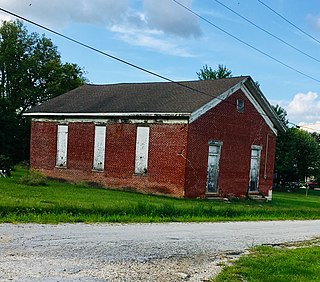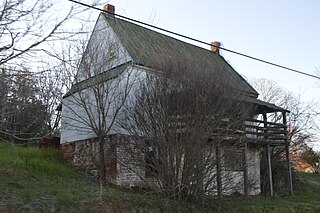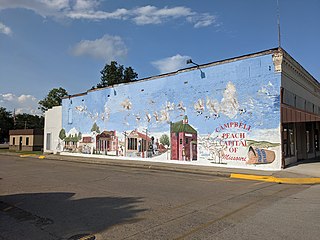
Clarksville is a city in Calumet Township, Pike County, Missouri, United States. The population was 372 at the 2020 census.

The Clarksville Historic District in Austin, Texas, is an area located west of downtown Austin near Lady Bird Lake and just northeast of the intersection of the Missouri Pacific Railroad and West Tenth Street. Many historic homes and structures are located within the Clarksville Historic District. While Clarksville is geographically part of the Old West Austin Historic District, it is distinct from the two historic neighborhoods of Old Enfield, which lies immediately to the north on the eastern side of Texas State Highway Loop 1, and Tarrytown, which is situated to the west and northwest on the western side of Mopac.

The First Christian Church is a historic Disciples of Christ church located at 101 North Tenth Street in Columbia, Missouri. It was designed by T.N. Bell of Chicago, Illinois and built in 1893. It has a Richardsonian Romanesque style Sanctuary that includes a square bell tower, horizontal massing with contrasting high gables, round arches, heavy and highly textured stone work, and voussoir arches. The Education Building was designed by Eugene Groves and added in 1929. This is the second church building to stand at this site. The building is still a functioning church today.

The Clarksville Historic District is a national historic district located at Clarksville, Mecklenburg County, Virginia. It encompasses 171 contributing buildings, 2 contributing sites, and 1 contributing structure in the central business district and surrounding residential areas of the town of Clarksille. Notable buildings include the Planters Bank (1909), Planters Brick Tobacco Sales Warehouse, Gilliland Hotel, the Russell's Furniture, former Clarksville High School (1934), Clarksville Presbyterian Church, Mount Zion Baptist Church, Jamieson Memorial Methodist Episcopal Church (1901), St. Timothy's Episcopal Church (1917), and St. Catherine of Siena Roman Catholic Church (1947). Located in the district are the separately listed Clark Royster House and the Judge Henry Wood Jr. House.

The Ozark Courthouse Square Historic District is a national historic district located at Ozark, Christian County, Missouri. It encompasses 19 contributing buildings in a 5.3-acre (2.1 ha) area in the central business district of Ozark. The central feature of the district, the Christian County Courthouse, is a three-story, Classical Revival style brick building designed by architect Henry H. Hohenschild. Other notable buildings include the Bank of Ozark/Masonic Lodge (1897), First Baptist Church (1919), Methodist Episcopal Church (1914), Robertson Brothers’ Store (1882), Ozark Drug (1905), Works Progress Administration Community Building (1934), Hospital, and Christian County Bank.

Northern Methodist Episcopal Church of Clarksville, also known as Bryant Chapel AME is a historic African Methodist Episcopal church located at 309 Smith Street in Clarksville, Pike County, Missouri. It was built in 1866 and remodeled in 1915, and is a one-story, rectangular, Greek Revival style brick church. It has a front gable roof.

Clifford–New Glasgow Historic District is a national historic district located at Clifford, Amherst County, Virginia. The district encompasses 43 contributing buildings, 6 contributing sites, and 6 contributing structures in the village of Clifford. The district includes a variety of residential, commercial, and institutional buildings built between about 1772 and 1961. Notable buildings include the St. Mark's Episcopal Church, the Saddlery (1814), and the Clifford Ruritan Building. Located in the district and separately listed are Brick House and Winton.

The Missouri-Pacific Depot-Clarksville is a historic railroad station between Cherry and Main Streets in Clarksville, Arkansas. It is a single-story masonry structure, built in 1910 by the Missouri-Pacific Railroad in the Mediterranean style. It is basically rectangular, with a projecting cross-gabled telegrapher's booth on the track side, which is topped by a distinctive parapeted gable. The roof has extended eaves supported by large Italianate brackets.

Downtown Smithville Historic District is a national historic district located at Smithville, Clay County, Missouri. It encompasses 30 contributing buildings in the central business district of Smithville. The district developed between about 1868 and 1964, and includes representative examples of Gothic Revival and Classical Revival style architecture. Notable buildings include the IOOF Lodge Hall / Smithville City Hall, C.C. Kindred Motor Company, The State Theater, Masonic Hall, First Christian Church (1927), Bank of Smithville / Citizens Bank and Trust (1889), Post Office, Methodist Episcopal Church, Smithville Community Hospital (1936), and Standard Service Station.

Capitol Avenue Historic District is a national historic district located at Jefferson City, Cole County, Missouri. It encompasses 107 contributing buildings in a predominantly residential section of Jefferson City. The district developed between about 1870 and 1947, and includes representative examples of Classical Revival, Late Victorian, Bungalow / American Craftsman, and Art Deco style architecture. Located in the district are the separately listed Lester S. and Missouri "Zue" Gordon Parker House, Jefferson Female Seminary, Missouri State Penitentiary Warden's House, and Ivy Terrace. Other notable buildings include the Parsons House (1830), former Missouri Baptist Building (1947), Grace Episcopal Church (1898), Elizabeth Alien Ewing House (1873), James A. Houchin House, J. Henry Asel, Sr. and Hilda Asel House (1898), Dix Apartments (1915), W.C. Young House, Bella Vista Apartments (1928), and Prince Edward Apartments (1930).

Historic District B is a national historic district located at Boonville, Cooper County, Missouri. It encompasses 23 contributing buildings in a predominantly residential section of Boonville. The district includes representative examples of Late Victorian style architecture. Notable buildings include the Dukes Residence (1900-1910), Windsor Residence, Hofstedler Residence (1920-1925), Short Residence (1908), Hain Residence (1836-1840), Hickam Estate Property (1840s), Christ Church Episcopal (1844-1846), and Christ Church Episcopal.

Historic District D is a national historic district located at Boonville, Cooper County, Missouri. It encompasses 87 contributing buildings in the central business district of Boonville. The district includes representative examples of Late Victorian and Classical Revival style architecture. Located in the district is the separately listed Lyric Theater. Other notable buildings include the Geiger's Furniture and Appliance (1870s), Missouri Power and Light Co (1900-1910), Palace Restaurant and Cocktail Lounge (mid-1800s), Boonville Music Co. (1870s), Nelson Memorial Methodist Church (1915-1917), United Missouri Bank (1914), Knights of Pythias Building (1920), First Presbyterian Church, P.N. Hirsch & Co. Department Store (1860s-1870s), Cooper County Recorder (mid-1800s), Cooper County Abstract and Insurance Co. (1910), and Cooper County Courthouse (1911-1912).

Campbell Commercial Historic District is a national historic district located at Campbell, Dunklin County, Missouri. The district encompasses 19 contributing buildings in the central business district of Campbell. The district developed between 1883 and 1930, and includes representative examples of Colonial Revival style architecture. Notable buildings include the Rice Hardware Company, Cotton Belt Hotel, City Hall (1906), Boyd's Department Store, and Pol-Mac Hotel.

Courthouse Square Historic District is a national historic district located at West Plains, Howell County, Missouri. The district encompasses 46 contributing buildings in the central business district of West Plains. It developed between about 1881 and 1950 and includes representative examples of Italianate, Queen Anne, Romanesque Revival, Late Gothic Revival, and Art Deco style architecture. Located in the district are the separately listed Elledge Arcade Buildings, W. J. and Ed Smith Building, and West Plains Bank Building. Other notable buildings include the IOOF Building #2, First Presbyterian Church, Howell County Courthouse (1937), Aid Hardware Building (1914-1915), W. N. Evans Building, J. R. Foster Building, Foster-Renfrew Building, Alsup, Risley & Skillman Block, Catron Opera House / Johnson Opera House (1893), IOOF Building / J. R. Galloway Building (1896), Evans Theatre, W. J. Zorn Building, #1/Howell County Gazette Building (1911-1912), West Plains Fire Department/City Hall (1917), and Avenue Theatre (1950).
Commercial Community Historic District is a national historic district located at Lexington, Lafayette County, Missouri. The district encompasses 106 contributing buildings and 1 contributing structure in the central business district and surrounding residential area of Lexington. It developed between about 1830 and 1930, and includes representative examples of Late Victorian and Gothic Revival style architecture. Located in the district is the separately listed Lafayette County Courthouse. Other notable buildings include the Lexington Racquetball Club, Missouri Public Service Storage Building, Franklin Diner, Wright House, Goehner's Marbleworks, First Presbyterian Church, Municipal Auditorium (1930), Leiter Apartments, Lafayette County Sheriff's Office and Jail (1939), Morrison Wentworth Bank Building, and Winkler Theatre.

Central Park Historic District is a national historic district located at Hannibal, Marion County, Missouri. The district encompasses 261 contributing buildings, 1 contributing site, and 4 contributing structures in a predominantly residential section of Hannibal. It developed between about 1840 and 1939, and includes representative examples of Romanesque Revival, Late Victorian, and Art Deco architecture. Located in the district are the separately listed Federal Building, Hannibal Old Police Station and Jail, and Eighth and Center Streets Baptist Church. Other notable contributing resources include Central Park with a war memorial monument and a life-size bronze statue of William Henry Hatch (1833-1894), City Hall (1909), old Missouri Guaranty Building (1894), Price Apartments (1904), YMCA (1910), Masonic Temple (1882), Park Methodist Church, Retards Row (1855), Elks Building (1925), Holmes Building, Security Building (1912), Kerchival-Iakenan-Lathrop House, Admiral Coontz Birthplace, Inmaculate Conception Chapel (1854), Episcopalian Trinity Church (1860), and William C. Henn House (1937).
Bonnots Mill Historic District is a national historic district located at Bonnots Mill, Osage County, Missouri. It encompasses 98 contributing buildings in the central business district and surrounding residential sections of Bonnots Mill. The district developed between about 1840 and 1942, and includes representative examples of Bungalow / American Craftsman and I-house architecture. Located in the district is the separately listed Dauphine Hotel. Other notable buildings include the Bonnots Mill School (1889), Henry Dieckriede House, Bonnots Mill United Methodist Church (1915), Bank of Bonnots Mill (1907), Bonnet's Mill Hotel / Krautman's Store, Meyer-Morfeld Milling Company, United States Post Office, St. Louis Parish Church and Rectory (1907), and St. Louis Parish School.

The Sedalia Commercial Historic District is a national historic district located at Sedalia, Pettis County, Missouri. It encompasses 102 contributing buildings in the central business district of Sedalia. The district developed between about 1870 and 1959, and includes representative examples of Italianate, Romanesque Revival, and Art Deco architecture. Located in the district are the separately listed Hotel Bothwell, Building at 217 West Main Street, and Missouri/Sedalia Trust Company. Other notable buildings include the First United Methodist Church (1888-1891), Pettis County Courthouse (1924), Anheuser Busch Bottling Works, the New Lona Theater (1920), Citizens National Bank Building, Third National Bank (1929), Federal Building (1930), Montgomery Ward Building (1936), the Uptown Theatre (1936), Missouri Pacific Depot, and Central Presbyterian Church.

The Clifford-Wyrick House is a historic house located at 105 South Second Street in Clarksville, Pike County, Missouri.

Turner-Pharr House is a historic home located at Clarksville, Pike County, Missouri. It was built about 1867, and is a two-story, five bay by three bay, transitional Greek Revival / Italianate style brick dwelling. It has a hipped roof. It features a three-bay front porch with Doric order columns that may date to about 1900.






















